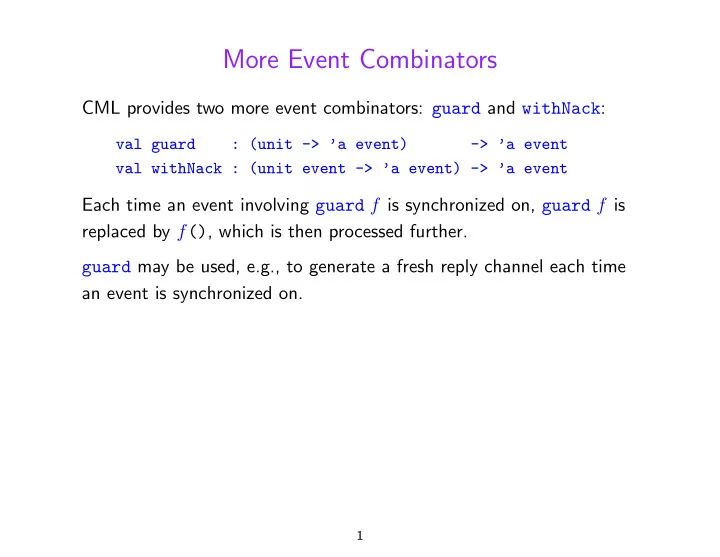

More Event Combinators CML provides two more event combinators: guard and withNack : val guard : (unit -> ’a event) -> ’a event val withNack : (unit event -> ’a event) -> ’a event Each time an event involving guard f is synchronized on, guard f is replaced by f () , which is then processed further. guard may be used, e.g., to generate a fresh reply channel each time an event is synchronized on. 1
More Event Combinators (Cont.) val guard : (unit -> ’a event) -> ’a event val withNack : (unit event -> ’a event) -> ’a event Each time an event involving withNack f is synchronized on, withNack f is replaced by f nev , which is then processed further, where nev is a fresh negative acknowledgment unit event that will become enabled if some event other than f nev is selected in the synchronization. For example, if choose [ ev , withNack f ] is synchronized on, but ev is eventually selected, then the negative acknowledgment event nev passed to f will become enabled, indicating that any operation begun by f nev should be aborted. 2
More Event Combinators (Cont.) val guard : (unit -> ’a event) -> ’a event val withNack : (unit event -> ’a event) -> ’a event Each time an event involving withNack f is synchronized on, withNack f is replaced by f nev , which is then processed further, where nev is a fresh negative acknowledgment unit event that will become enabled if some event other than f nev is selected in the synchronization. For example, if choose [ ev , withNack f ] is synchronized on, but ev is eventually selected, then the negative acknowledgment event nev passed to f will become enabled, indicating that any operation begun by f nev should be aborted. The guard functions of guard ’s and withNack ’s should run quickly; in particular, they shouldn’t block. 2-a
Recommend
More recommend